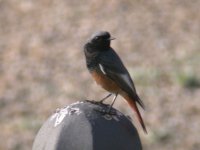During the Christmas period my father showed me a number of his recent photos, including the attached two of a redstart sp.
Both photos were taken in southern Spain in February 2007. Neither photo has been edited, other than reducing the size of the image.
My belief is that it is a male Black Redstart x Common Redstart hybrid, based on:
- Rufous belly and lower breast is not shown on local aterrimus form of Black Redstart
- Large white flash on the closed secondaries and tertials is not shown on any of the Middle Eastern and Asian forms of Black Redstart that do have a rufous belly
- Mantle colour appears a paler grey tone than black chest, a pro-Common Redstart feature whilst aterrimus is very black backed. Crown may also be paler grey than Black Redstart should be?
- Uneven cut-off between black, grey and rufous on the chest
I have a couple of questions;
- Anyone consider this not to be a hybrid? Have I overlooked a Black Redstart form?
- Just how common in the wild do hybrids of these two species occur?
- Anyone know of other photos of adult hybrids anywhere?
Cheers, BT
Both photos were taken in southern Spain in February 2007. Neither photo has been edited, other than reducing the size of the image.
My belief is that it is a male Black Redstart x Common Redstart hybrid, based on:
- Rufous belly and lower breast is not shown on local aterrimus form of Black Redstart
- Large white flash on the closed secondaries and tertials is not shown on any of the Middle Eastern and Asian forms of Black Redstart that do have a rufous belly
- Mantle colour appears a paler grey tone than black chest, a pro-Common Redstart feature whilst aterrimus is very black backed. Crown may also be paler grey than Black Redstart should be?
- Uneven cut-off between black, grey and rufous on the chest
I have a couple of questions;
- Anyone consider this not to be a hybrid? Have I overlooked a Black Redstart form?
- Just how common in the wild do hybrids of these two species occur?
- Anyone know of other photos of adult hybrids anywhere?
Cheers, BT





